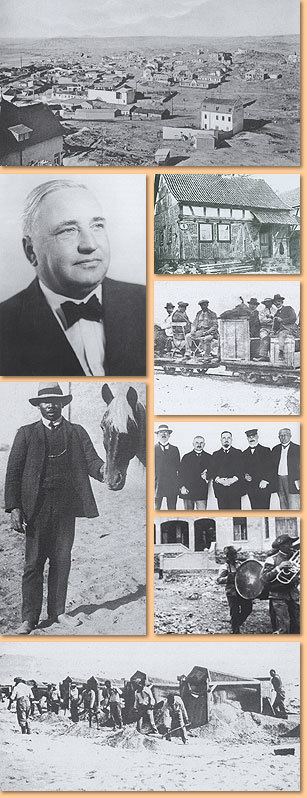Name August Stauch | ||
 | ||
August Stauch (* January 15, 1878 in Ettenhausen, † May 6, 1947 in Eisenach) is considered the discoverer of the diamond deposits near the settlement of Lüderitz in the then colony of German South West Africa, now Namibia.
August Stauch was the third of seven children of a railway worker's family in Ettenhausen. He was a railway employee in Thuringia, Germany. Stauch arrived in Lüderitz in 1907. He suffered from asthma and received medical advice that the drier desert climate may be suitable for his health. He took up mineralogy as a hobby in his spare time but later worked as a Bahnmeister (chief railway foreman) on the Lüderitzbucht-Aus railway line.
August developed a fascination for diamonds, after listening to the tales about Adolf Lüderitz, who believed there lay diamonds in the desert and obtained a prospecting license from Deutsche Kolonialgesellschaft fur Südwest Afrika. He consequently informed his workers, who had been brought in from South Africa because of their experience in railroad workings, to look out for unusually shiny stones. On 10 April 1908 Zacharias Lewala, one of his aides who had previously worked at a diamond mine in Kimberley, picked up a diamond near Grasplatz and dutifully took brought it to him.
Stauch quietly resigned from his job after confirming his suspicion that this may be a diamond, by scratching his glass watch with the stone. He found more pretty stones after a systematic search of the area and took them to his friend, mining engineer Sönke Nissen who lived in Lüderitz, where they were confirmed to be diamonds in June 1908.
These diamonds had flushed through the Orange River into the sea millions of years ago where the wind and waves washed it back in the sand of the Namib. The South West African diamonds are usually not very large, but clear like water and thus very popular on the market.
Stauch and Nissen initially kept the knowledge of the find to themselves, and only announced it after securing a 75-acre claim at Kolmanskop in order to continue to do diamond searching. Both were declared very wealthy men at the time.
A diamond rush set in, and the German government took immediate interest in the activities at Lüderitz, and dispatched the Secretary For The Colonies to investigate the situation and bring order and control to the industry. A diamond taxation system was introduced and the issuing of licenses was limited which brought about some order to the industry. The town of Lüderitz observed an economic boom between 1908 and 1914 and was temporarily known as Africa’s richest town.
Stauch tried to increase his wealth further and invested in many companies - both in the colony and in Germany. However in 1931, he lost most of his wealth through various misfortunes and the Great Depression. He returned and lived in his native town Ettenhausen and died in April 1947 as a poor man of stomach cancer. His family remained in South West Africa (now Namibia) to farm on the family ranch. It exists today and is managed by his grandson.
